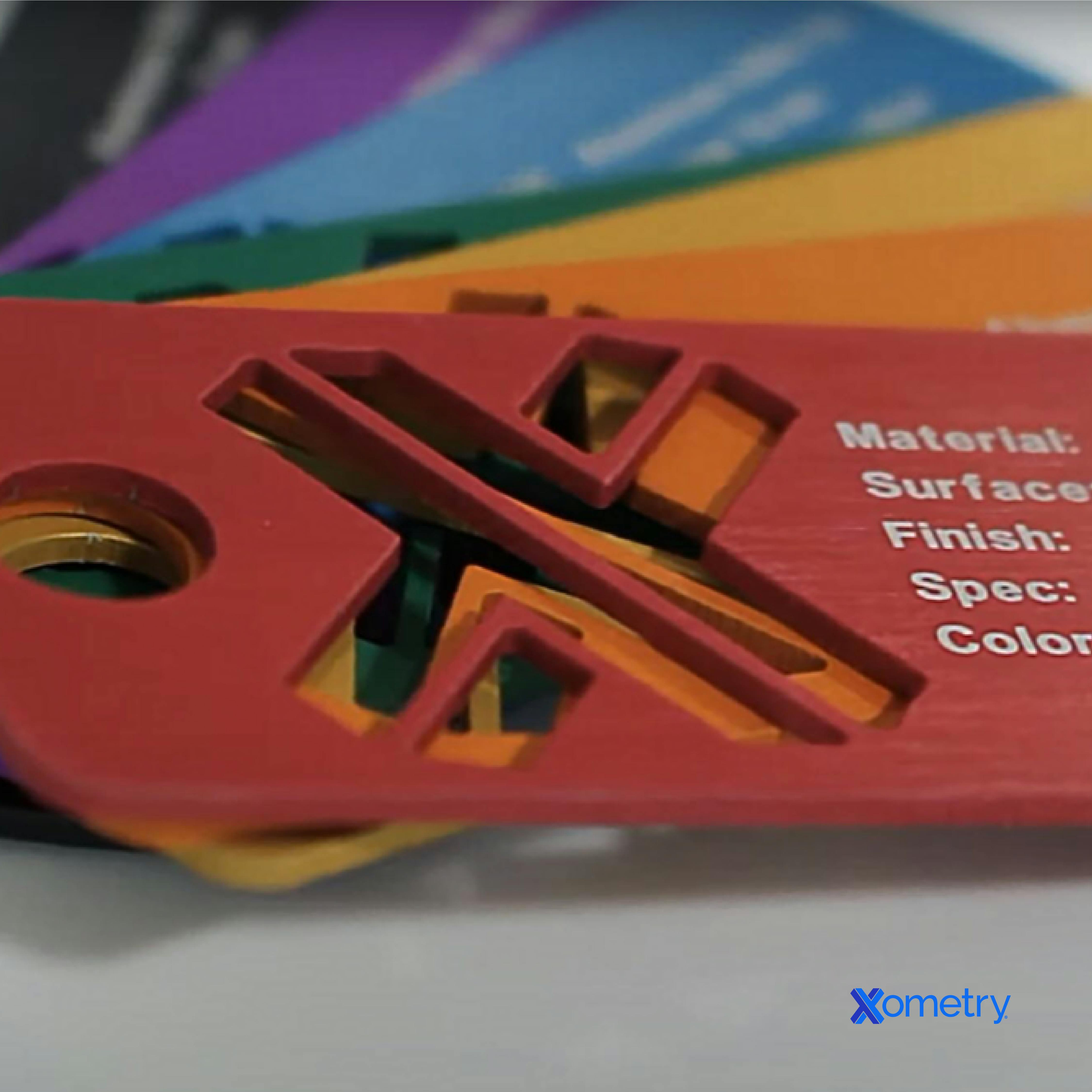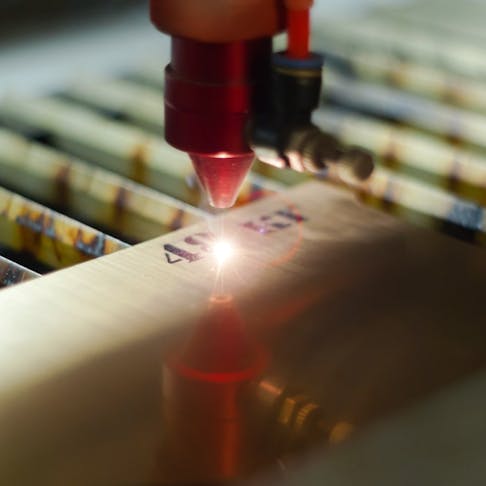Laser engraving involves making deep permanent marks on a metal surface. The incision occurs by focusing a laser beam onto the metal surface in a specified pattern, thus removing some materials through vaporization. Aluminum is a versatile material that’s become indispensable in most industries for its durability, exceptional corrosion resistance, and lightweight properties. It offers limitless design possibilities thanks to its numerous processing options. Thanks to this, it has found use in a range of industries including the aerospace, automotive, electronics, building, and construction fields, among others. Laser engraving in aluminum is an important part marking process as it embeds permanent codes on components for easy traceability.
Read on to discover how laser engraving in aluminum works, its pros and cons, and some tips to design for laser engraved aluminum part marking. If you’re looking to learn more about other types of marking, you can also check out our guide on direct and other part markings.

How Laser Engraving Works with Aluminum
A powerful beam acts as the chisel in aluminum laser engraving, vaporizing particles off the metal surface to incise deep marks. The laser engraver should radiate enough energy that the beam excites the surface material to its vaporization temperature, which for aluminum is 4,221 degrees F, or 2,327 degrees C. Vaporization happens within seconds to avoid generating liquid residue. Modern laser marking systems feature a fume extraction mechanism and an air knife. Fume extraction prevents the release of harmful fumes into the work environment, while the air knife safeguards the laser’s lens.
There are two types of lasers used in aluminum engraving: fiber laser systems and CO2 lasers. Fiber lasers operate at a wavelength that reacts better with metals. They are efficient in creating a high-contrast, durable mark without interfering with the integrity of the parts. They are also long-lasting and come at a lower price. This makes them common for industrial part marking applications. CO2 laser engraving of aluminum is also possible; these lasers can also be applied to non-metallic parts made from acrylics, woods, and natural stone, so they are more commonly used by manufacturers that handle a wider range of materials. Laser marking systems are controlled through computer software.
Aluminum laser markings remain on the surface permanently. This is important for aluminum specifically because workpieces from this material are exposed to numerous kinds of wear and surface treatments. Engravings do not wear out, tear, degrade, or get discarded no matter how long the component lasts or the processes it undergoes. That makes it a suitable marking process for parts that may undergo further rigorous treatments in the manufacturing process such as sandblasting and shot blasting. Laser etching aluminum can also be more beneficial to the environment than other marking methods if a suitable machine is used.
Why Aluminum Part Marking is Important
Why mark parts? As mentioned earlier, part marking enables accurate tracking of the serial number of a component through a marked QR code, data matrix code, or serial numbers. It’s also helpful in part identification and tracking statistics in component manufacturing and application. Part marking is thus vital for quality control and supply chain functions.
Other reasons for part marking include:
- To differentiate parts that look similar
- To facilitate part assembly
- To link the part or product to the company and machine on which it was produced
- For simple labeling
Laser Engraving Bare Aluminum vs Anodized Aluminum
Both bare and anodized aluminum can be engraved with fiber laser, though it can be more challenging to engrave bare aluminum with a CO2 laser than anodized aluminum.
The best system for engraving bare aluminum sheet metals is a fiber laser. For CO2 lasers, the operator must spray a special paste as a pretreatment for the metal. Then, the CO2 laser produces heat that glues the chiseling agent to the bare aluminum. The process takes time and calls for high power configuration. If not done at a low speed and with high power settings, the marks can easily wipe off, thus requiring a repeat job. Because of these factors, it can cost more to have a CO2 laser perform the same process. However, no material is removed with a CO2 laser marking, so the marking doesn’t affect the material’s integrity.
Anodized aluminum, however, can be engraved with equal ease using either type of laser. Anodized aluminum is simply aluminum with an oxide layer coating. This coating makes the material more corrosion and UV resistant while offering better lubrication and low-cost maintenance. This type of aluminum is easily laser engraved, whether using fiber or CO2 laser engraving. Because of this, it’s easier to create a permanent mark at low power and cost. However, the grade of anodized aluminum can affect the ease with which it is engraved; while Type I and II anodized aluminum has thinner layers that are easier to engrave on, Type III sheets requoire a higher power output to cut through the anodized coating.
Pros and Cons of Laser Engraving Aluminum
Laser engraving is used across manufacturing for a variety of industries, including automotive, aerospace, electronics, and healthcare. While laser engraving creates more permanent, high-quality marks compared to etching, ink stamping, or other methods, it also requires a high level of skill to perform and can fluctuate in lead times depending on the material. We go into more details below:
Pros of Aluminum Laser Marking
The benefits of laser marking include:
- Permanency of the markings.
- Increased efficiency compared to mechanical engraving.
- More precise marks in comparison with methods like ink stamping.
- Increased eco-friendliness in some machines (as less waste is released into the environment).
- Reduced risk of fake parts infiltrating the downstream supply chain.
Cons of Laser Engraving
- Laser engraving requires a high level of operator skill, especially when designing and setting the laser machine. It's important to find a shop with the experience to accomplish this process, which is where Xometry's highly skilled manufacturer network is so useful.
- Production speed isn’t always the same, depending on the material’s density, and it can use a lot of energy. Both of these can drive up costs.
- Some laser cutters release hazardous fumes. Fumes can be a significant cause of environmental pollution.
How to Design for Laser Engraved Aluminum Part Marking
Design considerations for laser engraving aluminum are similar to those for other laser engraving and marking types. We go into more detail on part marking design best practices in our guide to part marking, but here are some of the most important factors to keep in mind:
- Try to simplify your design as much as possible; complexity increases cost.
- Submit your design as a vector file (such as a DXF) to ensure it doesn’t lose quality in the process of engraving. Pixel-based files like JPEGs lose definition.
- Make sure you include all required marking dimensions in the final submission, especially engraving depth and character size.
- Don’t forget to include where you want the marking to go.
Conclusion
Laser engraving is a fast and cost-effective method of marking parts, popular in the aerospace, electronics, and other industries for its precise, long-lasting and high-quality marks. If you’re ready to order engraving for your aluminum or other parts, you can get an instant quote from Xometry today. You can also find out more about other kinds of engraving in our guide to direct part marking.
Sources:

